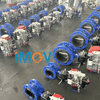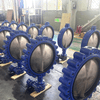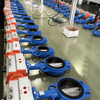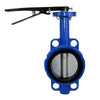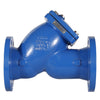Pneumatic Butterfly Valve Basics: What It Is and How It Works
What Is a Pneumatic Butterfly Valve?
A pneumatic butterfly valve uses a pneumatic actuator to convert the energy of compressed air into stable, controllable rotary torque. This torque drives the stem and disc to rotate 90°, allowing the valve to open, close, or modulate flow.
Because compressed air offers excellent controllability, reliability, and repeatability, pneumatic actuators have become one of the most widely used drive mechanisms in modern industrial automation.
Main Components of a Pneumatic Butterfly Valve

|
Component |
Function Description |
|
Travel Adjustment Screws |
Fine-tune the valve’s rotation angle to ensure accurate fully-open and fully-closed positions. |
|
Visual Position Indicator |
Shows the current valve position at a glance—open, closed, or anywhere in between. |
|
End Caps |
Seal both ends of the actuator’s air chambers; house the internal springs in single-acting models. |
|
Actuator Body |
The main housing that contains the piston, rack-and-pinion mechanism, and other drive components. |
|
Air Ports A & B |
Connect to the air supply or solenoid valve to control the actuator’s opening and closing direction. |
|
NAMUR Solenoid Valve Interface |
A standardized mounting interface that allows the solenoid valve to be installed directly on the actuator. |
|
Valve Body |
The main valve housing that connects to the pipeline and withstands system pressure. |
|
Valve Disc |
The rotating disc that regulates flow as it turns within the valve body. |
|
Valve Seat |
The sealing surface that contacts the disc to ensure tight shutoff and prevent leakage. |
How a Pneumatic Butterfly Valve Works
Pneumatic butterfly valves generally use one of two actuator types: spring-return (single acting) or double acting.
Although both drive the disc through a 90° rotation, their internal mechanisms work quite differently.
Single-Acting Pneumatic Butterfly Valve (Spring Return)
A single-acting actuator has only one air inlet.
When compressed air is applied, the actuator generates torque to rotate the disc into the open or closed position. When the air supply is released, a large internal spring forces the actuator back to its default position, bringing the disc with it.
This built-in “fail position” (fail-open or fail-close) makes single-acting valves ideal for systems where the valve must automatically return to a safe state during a power or air-supply failure—such as emergency shutdown lines or safety-critical water/air circuits.
Double-Acting Pneumatic Butterfly Valve
A double-acting actuator contains no springs. Instead, it uses two air inlets to alternately pressurize each side of the piston.
One air signal rotates the disc to the open position, and a second air signal rotates it back in the opposite direction to close the valve.
Double-acting actuators provide higher output torque, faster response, and longer service life. They are preferred in applications requiring frequent cycling, rapid opening/closing, or the ability to overcome higher differential pressure.
Choosing Between the Two
Selecting the right pneumatic butterfly valve depends on the system’s operating conditions:
- Single-acting is the better option when a defined fail-safe position is required.
- Double-acting is ideal for bidirectional flow, frequent actuation, and applications demanding higher torque.
Advantages of Pneumatic Butterfly Valves
-
High Safety
Powered by compressed air instead of electricity, pneumatic valves eliminate the risk of sparks, making them suitable for chemical plants, dusty environments, and any area with explosion-proof requirements. -
Simple, Reliable Construction
The actuator uses a straightforward mechanical design with fewer moving parts, resulting in low failure rates and minimal maintenance needs. -
Fast and Responsive
Pneumatic systems react quickly, making them ideal for applications that require frequent cycling or rapid open/close action. -
Excellent Control Capability
Air pressure and flow can be easily regulated, allowing the valve to achieve smooth, consistent, and relatively precise modulation performance.
Pneumatic vs. Electric Butterfly Valves
In automated control systems, pneumatic and electric butterfly valves are two of the most commonly used actuation methods.
Although both perform the same basic function, their different drive principles lead to notable distinctions in control behavior, application suitability, and performance. Understanding these differences is essential for correct valve selection.
Differences in Drive Principle and Construction
-
Pneumatic Butterfly Valve
Powered by compressed air, the pneumatic actuator converts air pressure into rotational torque using pistons or a rack-and-pinion mechanism. Because the design is predominantly mechanical and relatively simple, pneumatic valves deliver fast response and are well-suited for high-cycle operation. -
Electric Butterfly Valve
Electric valves use an electric motor paired with a gearbox and electronic control circuitry to rotate the stem and disc. The structure is more complex but provides smooth operation, stable positioning, and high precision. This makes electric butterfly valves a better choice for applications requiring accurate flow control or fine adjustment.
Operating Speed and Control Performance
Pneumatic butterfly valves are known for their rapid response.
A full open–close cycle typically takes only 0.3–1 second, making them ideal for applications that demand fast shutoff or high-frequency cycling—such as compressed air lines, emergency shutdown systems, or fire‐water networks.
Electric butterfly valves operate more slowly, usually requiring 5–15 seconds for a full stroke. However, they offer much higher control accuracy and are well-suited for proportional control, position feedback, and smart automation. This makes electric valves a common choice on production lines where precise flow or position control is required.
Safety and Application Environment
Because pneumatic valves are powered by compressed air, they are inherently explosion-proof and do not produce sparks. This makes them especially suitable for chemical plants, oil and gas facilities, dusty environments, and pipelines carrying flammable media.
Additionally, spring-return designs provide automatic fail-safe action in the event of air loss, ensuring the valve returns to a predefined safe position.
Electric butterfly valves, on the other hand, rely on electric motors.
In hazardous areas, this requires explosion-proof motors or specialized control equipment, which increases cost.
However, in standard environments—such as water supply networks, HVAC systems, and building automation—electric valves often perform better thanks to their precise positioning, easy installation, and smooth operation.

If your application requires fast response, frequent cycling, intrinsic safety, or you already have a compressed air supply in place, a pneumatic butterfly valve is the stronger choice.
If your system prioritizes accurate modulation, ease of installation, or you are operating in non-hazardous environments without compressed air, an electric butterfly valve will typically be more suitable.
Selecting the right pneumatic or electric butterfly valve is key to keeping your system safe, fast, and reliable. A good understanding of both options helps you make the best choice for your application.
If you need pneumatic butterfly valves or want guidance on choosing the right actuator type, Union Valve is here to support you. We provide dependable products and straightforward technical advice for many different industries and working conditions.
Please feel free to contact us if you have any further questions.
